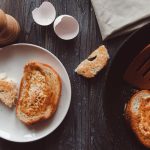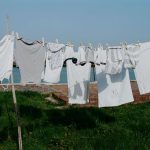Curious if there's a homemade goo be gone recipe that's gentle on fabrics? You're not alone. Dealing with sticky residues on your favorite fabrics can be a real challenge. But fear not! With the right approach, you can effectively tackle gooey messes without harming your fabrics.
By exploring natural solvents and testing DIY recipes, you can find a fabric-friendly goo be gone solution that works for you. It's all about understanding the nature of the residue, assessing fabric compatibility, and implementing safe application techniques.
So, let's dive in and uncover the best options for safely removing stubborn goo from your beloved fabrics.
Key Takeaways
- Harsh chemicals and rough scrubbing can damage delicate fabrics, so it's important to use a gentle approach when removing sticky residues.
- Testing any cleaning solution on a small, inconspicuous area first is essential to ensure that it doesn't cause any damage or discoloration to the fabric.
- Vinegar, lemon essential oil, diluted rubbing alcohol, and coconut oil are natural solvents that can effectively remove gooey residues from fabrics.
- Different fabrics require specific care for stain removal, so tailor the homemade recipe based on the fabric type and nature of the stain.
Understanding Gooey Residue on Fabrics
If you've ever struggled to remove sticky residue from your favorite fabrics, you're not alone. Gooey stains can be a real hassle, but understanding how to handle them is crucial for effective fabric care and preservation. When it comes to removing sticky residue from fabrics, it's important to approach the task with care and precision. Harsh chemicals and rough scrubbing can damage delicate fabrics, so it's essential to use gentle methods for effective removal.
One method for removing sticky residue from fabrics is to use a solution of warm water and mild detergent. Gently dab at the affected area with a soft cloth, being careful not to rub too vigorously. For tougher residues, applying a small amount of rubbing alcohol or vinegar to the stain can help break it down before washing. Always remember to test any cleaning solution on a small, inconspicuous area of the fabric first to ensure it won't cause damage.
Exploring Natural Fabric-Safe Solvents
When dealing with sticky residue on fabrics, you can explore natural fabric-safe solvents to effectively remove the gooey stains without causing damage. Natural alternatives offer gentle yet potent solutions for fabric care, ensuring that your garments remain in pristine condition.
Here are five natural fabric-safe solvents to consider:
- Vinegar: This common household item acts as a natural solvent, breaking down sticky residues without harming the fabric.
- Lemon Essential Oil: Known for its grease-cutting properties, lemon essential oil can help dissolve sticky substances on fabrics.
- Rubbing Alcohol: Diluted rubbing alcohol can effectively remove gooey residues from fabrics without leaving a harsh chemical odor.
- Coconut Oil: Surprisingly, coconut oil can be used to lift sticky residues from fabrics, and it also leaves a pleasant scent.
- Baking Soda: When combined with water to form a paste, baking soda can gently exfoliate and lift sticky stains from fabrics.
Testing DIY Goo Be Gone Recipes
To effectively remove sticky residues from fabrics, you can test various DIY Goo Be Gone recipes that use natural solvents. Testing the effectiveness of eco-friendly alternatives is crucial in finding a homemade solution that not only removes gooey substances but also preserves the integrity of the fabric. Below is a comparison table to help you assess the effectiveness of different DIY Goo Be Gone recipes.
| Goo Be Gone Recipe | Ingredients | Effectiveness |
|---|---|---|
| Vinegar Solution | Vinegar, Water | High |
| Baking Soda Paste | Baking Soda, Coconut Oil | Moderate |
| Lemon Essential Oil | Lemon Essential Oil, Olive Oil | Low |
| Rubbing Alcohol Solution | Rubbing Alcohol, Water | High |
| Dish Soap Mixture | Dish Soap, Warm Water | Moderate |
Assessing Fabric Compatibility
When assessing fabric compatibility for homemade Goo Be Gone recipes, it's important to consider the specific fabric types and the nature of the stain you're dealing with. Different fabrics may react differently to certain ingredients, so it's essential to understand the potential effects before applying any solution.
Fabric Types and Removal
Assessing the compatibility of your fabric types for Goo Be Gone removal is crucial for preserving the integrity of your belongings.
Different fabrics require specific care to ensure successful removal without causing damage. Consider the following when assessing fabric compatibility:
- Natural vs. Synthetic: Determine if the fabric is natural (cotton, wool) or synthetic (polyester, nylon) as this affects the approach to removal.
- Delicate vs. Sturdy: Evaluate the fabric's durability to choose the appropriate removal method.
- Colorfastness: Check if the fabric's color is stable to avoid discoloration during the removal process.
- Texture: Consider the texture of the fabric as it impacts how it will interact with the removal solution.
- Previous Treatments: Be mindful of any prior treatments or cleaning techniques used on the fabric that may affect Goo Be Gone's effectiveness.
Understanding these factors will help you assess fabric compatibility and choose the best approach for safe and effective Goo Be Gone removal.
Stain-Specific Fabric Solutions
Assess the fabric type to determine the most suitable homemade Goo Be Gone recipe for effective stain removal. Different fabrics require specific care to ensure that stains are effectively and safely removed. For example, delicate fabrics such as silk or wool may require a gentler homemade solution to avoid damaging the fibers. On the other hand, tougher fabrics like denim or cotton can withstand a more robust homemade Goo Be Gone recipe to tackle stubborn stains.
When dealing with fabric stains, it's crucial to consider the compatibility of the cleaning solution with the fabric to prevent any potential damage. By understanding the nature of the fabric and the type of stain, you can tailor the homemade Goo Be Gone recipe to provide effective stain removal while also caring for the fabric.
Implementing Safe Application Techniques
To ensure effective and safe removal of goo from fabric, follow proper application techniques. When dealing with goo on fabric, it's important to use safe application methods to prevent damage and ensure successful removal. Here are some key tips to consider:
- Spot Testing: Before applying any homemade goo remover, always spot test it on a small, inconspicuous area of the fabric to ensure it won't cause discoloration or damage.
- Gentle Application: Use a soft cloth or sponge to apply the homemade goo remover gently onto the affected area. Avoid scrubbing vigorously, which could cause the goo to spread or embed further into the fabric fibers.
- Patience: Allow the homemade goo remover to sit on the fabric for a few minutes to effectively break down the goo. Rushing the process could lead to incomplete removal or fabric damage.
- Blotting Technique: Instead of rubbing the fabric, use a blotting motion to lift the goo off the fabric. This helps prevent the goo from spreading to unaffected areas.
- Rinse and Dry: After removing the goo, rinse the fabric with water and allow it to air dry. Avoid using excessive heat, as it could set any remaining goo or cause damage to the fabric fibers.
Conclusion: Fabric-Friendly Goo Be Gone Options
After implementing safe application techniques, you can now explore fabric-friendly options for removing goo. When dealing with delicate fabrics, it's crucial to opt for non-toxic alternatives and gentle cleaning methods to avoid damaging the material.
One effective fabric-friendly goo remover is a mixture of baking soda and coconut oil. The baking soda acts as a mild abrasive, gently lifting the goo from the fabric, while the coconut oil helps to break down the residue without causing any harm to the fibers.
Another option is to use white vinegar, which is known for its gentle yet effective cleaning properties. Simply dab a small amount onto the affected area and let it sit for a few minutes before gently blotting it with a clean cloth.
For particularly stubborn goo, consider using a small amount of rubbing alcohol on a cotton ball to carefully dab at the residue.
Remember to always test any homemade solution on a small, inconspicuous area of the fabric first to ensure compatibility.
With these fabric-friendly alternatives, you can effectively tackle goo without compromising the integrity of your cherished fabrics.
Frequently Asked Questions
Can This Homemade Goo Be Gone Recipe Be Used on Delicate Fabrics Like Silk or Wool?
You can safely use this homemade goo be gone recipe on delicate fabrics like silk and wool. It's gentle and effective, ensuring silk care and wool preservation. Just apply, let it sit, and gently remove the goo.
Are There Any Potential Side Effects or Damage to Fabrics From Using This Homemade Goo Be Gone Recipe?
When using a homemade goo be gone recipe on fabrics, consider potential risks and fabric compatibility. While effective, longer application times may damage delicate fabrics. Always test on a small, hidden area first to ensure safety.
How Long Should I Let the Homemade Goo Be Gone Solution Sit on the Fabric Before Attempting to Remove the Residue?
Let the homemade goo be gone solution sit on the fabric for about 5-10 minutes to effectively remove sticky residues. Afterward, gently blot the area with a clean cloth. Always spot test first to ensure fabric-friendliness.
Can This Homemade Goo Be Gone Recipe Be Used on Colored or Patterned Fabrics Without Causing Fading or Discoloration?
On colored or patterned fabrics, the homemade goo be gone solution may cause fading or discoloration. To avoid potential side effects, it's crucial to test on a small area first and limit the residue removal time.
Are There Any Specific Types of Goo or Sticky Residues That This Homemade Goo Be Gone Recipe May Not Be Effective On?
When dealing with different types of sticky residues, it's important to note that the effectiveness of homemade goo be gone recipe may vary. Consider the specific material and the nature of the residue for safe and effective removal.
- The Impact of Fiber Type on Nonwoven Fabric Properties - July 11, 2025
- Nonwoven Fabric in the Furniture and Bedding Industry - July 11, 2025
- What Is PET Spunbond Nonwoven Fabric? - July 11, 2025







